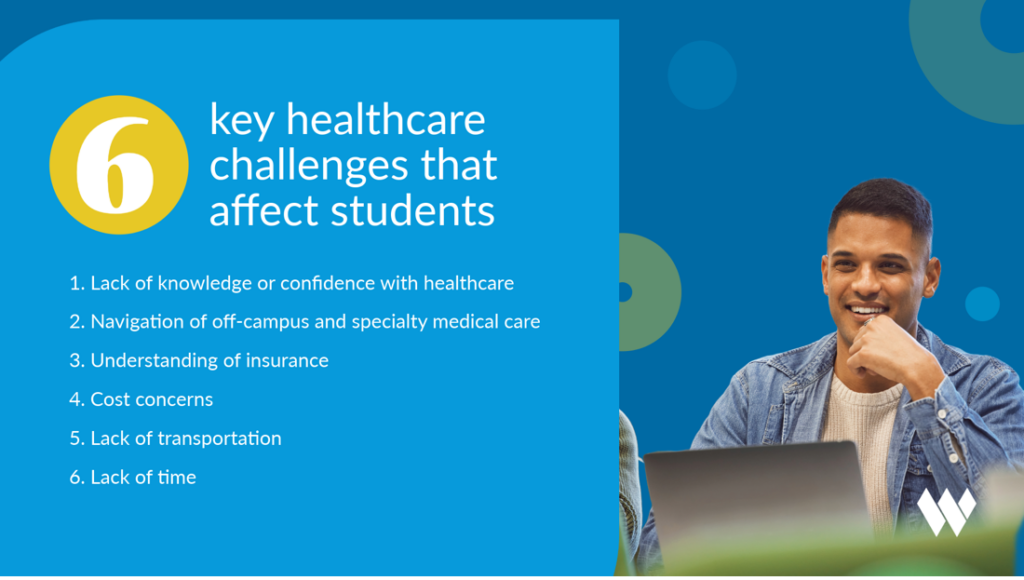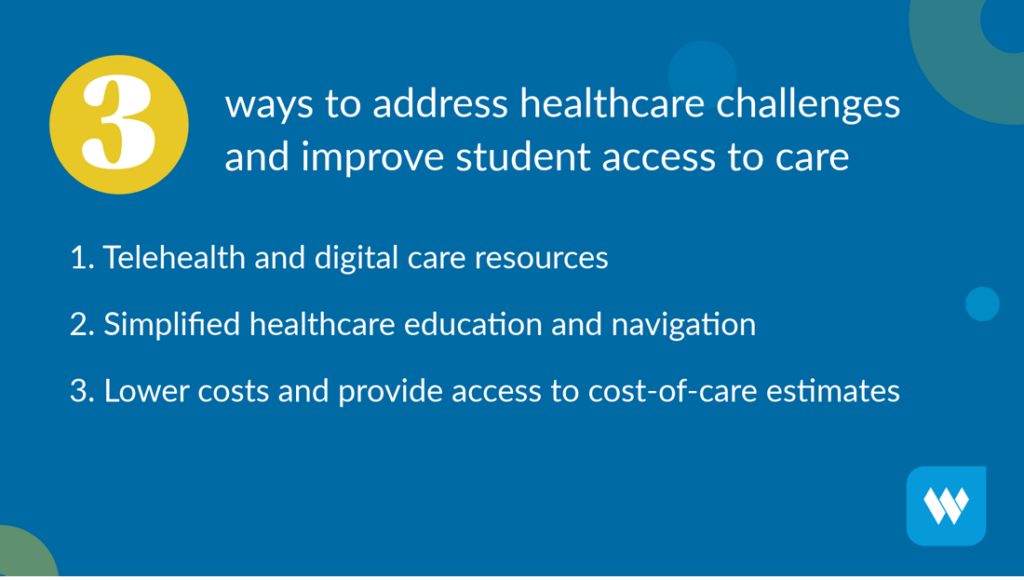Students face unique challenges when it comes to healthcare. Understanding these challenges can help us provide better solutions and support, making healthcare easier for students to navigate.
We sat down with Jenn Stevens, Wellfleet’s VP of Healthcare Optimization, to discuss the student healthcare experience. Her insights highlight students’ concerns and how we can work together to serve their needs better.
1. Lack of knowledge or confidence with healthcare
Many students are inexperienced with healthcare. They are often new to setting up appointments, managing care and medications, and paying medical bills. This can be overwhelming and intimidating, and students often don’t know where to turn when they have questions about managing their care.
2. Navigation of off-campus and specialty medical care
To support students and make the transition easier, some schools provide healthcare options on campus, for example, through a student health center or counseling center.
While this service is an excellent first line of care for many students, students can have a more challenging time when they need more complex or specialized care that’s only available off-campus. For example, if students have a concern that requires the consultation of a surgeon, endocrinologist, physical therapist, or psychiatrist, they may have difficulty knowing how to get care.

3. Understanding of insurance
Another important barrier for students is that they often struggle with the complexity of health insurance and how payments work for medical services. Navigating in-network vs. out-of-network providers, determining which services are covered, and understanding what terms like deductible and coinsurance mean — it can get very confusing for students who are new to the health insurance world.
4. Cost concerns
Healthcare can be expensive. There is no question about that. And students often deal with financial insecurity because of the cost of their education and their limited hours available for work.
In fact, according to Trellis, 73% of undergraduate students report having experienced financial difficulty while in college, and 57% of students would have trouble finding $500 in an emergency. This is a concerning statistic, and it emphasizes how important it is to lower the costs of healthcare for students.
5. Lack of transportation
Transportation can hinder students from accessing care. Students may not have a vehicle on campus, public transportation may be limited, and hired transportation can be costly, which makes visiting off-campus providers inconvenient. These factors create more difficulty in getting the care they need.
6. Lack of time
Another healthcare barrier for students can be a lack of time. They manage a rigorous course load in addition to their social activities, athletic and extracurricular commitments, work responsibilities, and family needs. Their busy schedules can make it difficult to find the time to seek care. Even attending an appointment amid the busy school day can be challenging. Often, students simply don’t have the time to prioritize their healthcare as they would like.

3 ways to address these challenges and improve student access to care
Now that you understand the primary pain points for students when seeking care, here are a few ways to combat them and provide your students with easier access to the right care.
1. Telehealth and digital care resources
The first way to address students’ healthcare challenges is to make getting care easier and more convenient. Many campuses have student health centers, which are excellent for students, but some students need to seek more specialized care that may not be available on campus.
So, providing an easier way to receive care is essential. Allowing students to meet with providers from their homes reduces many barriers to care, including timing, transportation, and cost.

Telehealth and digital care options can include:
- Virtual visits with an in-network provider
- Telehealth medical and behavioral care appointments, such as through Teladoc
- A 24/7 hotline for behavioral health emergencies, such as CareConnect by Wellfleet
- Digital behavioral health programs, such as Silvercloud® by Amwell®
2. Simplified healthcare education and navigation
Another key to addressing students’ care needs is ensuring students know where to go for their care. They need to understand what different providers offer, what situations warrant an emergency versus routine visit, and the cost differences between types of facilities.
Educational resources and tools can be instrumental in helping students better understand their healthcare options. “We’ve learned from student feedback that brevity and ease of finding information are key,” said Stevens.
Some ways to educate students include:
- Brief narrated videos
- FAQs
- On-demand resources
- Customer service chat
Additionally, rather than simply offering a document that lists the available options under the healthcare plan, students can benefit from more guidance when deciding what type of care they need.
For example, offering an intuitive online care navigator is a great option. With this type of digital tool, students answer a few questions about their health situation and preferences. Then, they’re directed to the right service, such as an urgent care facility, student health center, or telehealth provider. Wellfleet is working toward launching a tool with these features in 2024.
Additionally, health insurance carriers need to go further for students with more complex needs to help them navigate their care. “A student health plan should offer more specialized customer service and case management for students with more complex needs,” said Stevens.
3. The third way to help support students and break down their barriers to care is to help them with the financial side of their healthcare.
First, this means ensuring student costs remain low and out-of-pocket costs for appointments and medications are reasonable. There are many ways to lower healthcare costs for students, from lowering medication costs to scrutinizing claims to negotiating with providers.
Here are five ways colleges can combat the rising costs of healthcare.
Additionally, it’s important to provide cost-of-care estimations so students can shop for lower costs for services, be aware of costs ahead of time, and budget accordingly.
Learn more about Wellfleet’s Cost of Care tool in our blog.

Learn more about Wellfleet
At Wellfleet, we’re always working to improve the student healthcare experience.
“Anything you do to improve education and access to healthcare can help reduce overall costs and improve the student healthcare experience,” said Stevens.
A health plan built for students, we’re experts at customizing health coverage for the needs of college students. Whether increasing cost transparency or finding savings opportunities, we have students at the forefront of our minds.
Contact our Sales team to learn more about how we can provide the right solution for your students.
CSR-SHIP-JANUARY-2024-19


